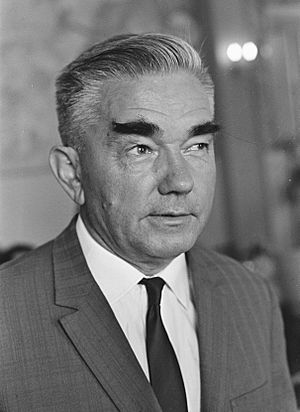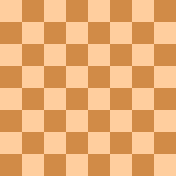Alexander Kotov facts for kids
Quick facts for kids Alexander Kotov |
|
|---|---|

Kotov in 1967
|
|
| Full name | Alexander Alexandrovich Kotov |
| Country | Soviet Union |
| Born | 12 August 1913 Tula, Russian Empire |
| Died | 8 January 1981 (aged 67) Moscow, Soviet Union |
| Title | Grandmaster |
| Peak rating | 2510 (July 1971) |
Alexander Alexandrovich Kotov (Алекса́ндр Алекса́ндрович Ко́тов; 12 August 1913 – 8 January 1981) was a Soviet chess grandmaster and author. He was a Soviet chess champion and a two-time world title Candidate. Kotov also wrote many books about chess. He held important positions in Soviet chess. His work was very important and made him one of the best chess writers ever.
Contents
Early Life and Chess Beginnings
Kotov was born in Tula, which was part of the Russian Empire. He came from a family that worked hard. In 1939, he moved to Moscow to study engineering. During this time, he also spent a lot of time learning chess.
Alexander Kotov's Chess Career
Today, many people know Alexander Kotov best as a writer. But he also had some great results as a chess player.
Early Successes
One of his best early achievements was in the 1939 USSR Championship. He almost won, but Mikhail Botvinnik beat him in the last game. This result earned Kotov the title of Soviet Grandmaster. He was only the third Soviet player to get this title. The others were Botvinnik and Grigory Levenfish. Kotov also became the Moscow champion in 1941. In 1948, he shared the Soviet title with David Bronstein. He also won a tournament in Venice in 1950, beating Vasily Smyslov.
World Championship Challenges
In 1950, the first-ever Candidates Tournament was held in Budapest. This tournament decided who would challenge the World Champion. Kotov scored 8.5 out of 18 points. He had earned his spot by finishing fourth in the 1948 Interzonal Tournament. In 1950, the World Chess Federation gave him the title of International Grandmaster. He also held important jobs in the Soviet Chess Federation.
Perhaps Kotov's best result was at the 1952 Saltsjöbaden Interzonal tournament. He won it with an amazing score of 16.5 out of 20 points. He was three points ahead of Tigran Petrosian and Mark Taimanov. He did not lose a single game in this tournament. In the next Candidates Tournament in Zürich, he scored 14 out of 28 points. He was the only player to win a game against the tournament's winner, Smyslov.
Team Play and Later Years
Kotov played for the Soviet Union in the Chess Olympiads in 1952 and 1954. His team won gold medals both times. He played as a reserve player. In Helsinki 1952, he scored 2 out of 3 points. In Amsterdam 1954, he scored 4 out of 6 points. After 1960, he played in tournaments only outside the Soviet Union. He shared first place with Svetozar Gligorić at Hastings in 1962. He played in very few tournaments in his later years.
Alexander Kotov's Writings
Kotov wrote many insightful and helpful books about chess. He wrote in a friendly style. He often shared personal stories about famous grandmasters he knew. He even made fun of himself sometimes to make a point clearer. For example, in Think Like a Grandmaster, he showed times when his opponents outsmarted him. In one game, he made a big mistake that turned a sure win into an instant loss. These fun and educational stories made his books popular with chess players everywhere.
Books on Alekhine
Kotov greatly admired World Champion Alexander Alekhine. He wrote a detailed two-volume series about Alekhine's life and chess career. These books were called Shakhmatnoe Nasledie A.A. Alekhina. They were published between 1953 and 1958. They were translated into several languages. His work helped Alekhine become respected again in the Soviet Union.
The "Think Like a Grandmaster" Series
His most famous books are the trilogy: Think Like a Grandmaster, Play Like a Grandmaster, and Train Like a Grandmaster. Think Like a Grandmaster is especially well-known. It was translated into English in 1971. This book does not tell you where to move your pieces. Instead, it teaches you how to think during a game. Kotov advised players to find many possible moves, called candidate moves. Then, they should carefully examine each one to build an "analysis tree." This advice is still well-known today.
Kotov also helped with the Yugoslav series Encyclopedia of Chess Openings (ECO). This series started in 1974. He also contributed to the related games book series Chess Informant as an analyst.
Kotov's Playing Style
Kotov had a sharp playing style. He was not afraid of complicated positions on the chessboard. He would willingly enter them, even against the best players. As White, he preferred closed openings. As Black, he was very successful with the Sicilian Defence.
"Kotov Syndrome"
In his 1971 book Think Like a Grandmaster, Kotov described a common problem for chess players. He called it "Kotov syndrome." This happens when a player thinks very hard for a long time in a difficult position. But they cannot find a clear plan. Then, because they are running out of time, they quickly make a bad move. This move is often a big mistake, called a blunder.
Notable Chess Games
| This section uses algebraic notation to describe chess moves. |
| h | g | f | e | d | c | b | a | ||
| 1 |

|
1 | |||||||
| 2 | 2 | ||||||||
| 3 | 3 | ||||||||
| 4 | 4 | ||||||||
| 5 | 5 | ||||||||
| 6 | 6 | ||||||||
| 7 | 7 | ||||||||
| 8 | 8 | ||||||||
| h | g | f | e | d | c | b | a | ||
Kotov played 30...Qxh3+ as a queen sacrifice.
- Alexander Kotov vs Alexander Tolush, Leningrad Championship 1938, Neo-Grunfeld Defence (D76), 1–0 Tolush was a dangerous attacker. But Kotov controlled the game here.
- Alexander Kotov vs Tigran Petrosian, USSR Championship, Moscow 1949, Queen's Gambit, Exchange Variation (D36), 1–0 Petrosian, who later became World Champion, lost a game he would not forget. He fell into an opening trap and gave up after only 13 moves.
- Alexander Kotov vs Paul Keres, Budapest Candidates Tournament 1950, Nimzo-Indian Defence, Saemisch Variation (E24), 1–0 Kotov was playing at his best. He gave Keres a costly loss.
- Yuri Averbakh vs Alexander Kotov, Zurich Candidates Tournament 1953, Old Indian Defence (A55), 0–1 This is Kotov's most famous game. It is one of the greatest games with sacrifices. Black gives up his Queen for a long-term advantage. This eventually leads to a checkmate. This game won the "Brilliancy Prize" at Zurich. Zurich is known as one of the greatest chess tournaments ever.
See also
 In Spanish: Aleksandr Kótov para niños
In Spanish: Aleksandr Kótov para niños

